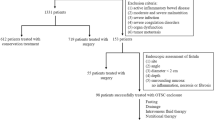Abstract
Aim
To investigate the effectiveness of over-the-scope-clip (OTSC)-based endoscopic closure in patients with perforated peptic ulcer (PPU).
Methods
One hundred six patients diagnosed with PPU were treated with either OTSC (n = 26) or conservative treatments (n = 80), respectively. The outcome assessments included technical success rate, clinical success rate, post-treatment complications after 1 month, mortality rate, time to resume oral feeding, length of hospital stay, and the administration of antibiotics.
Results
In the OTSC group, technical and clinical success was achieved in 100% of patients without any complications, including death, incomplete closure, duodenal obstruction, and gastrointestinal bleeding, with a median operation time of 10 min. All patients in the OTSC group were discharged, while the mortality rate in the control group was 13.8%. Subsequent surgeries were required in 30% of patients in the control group. The median times to resume oral feeding were 3.5 (interquartile range [IQR] 2.0–5.25) days in the OTSC group and 7.0 (IQR 5.0–9.0) days in the control group (p < 0.001). One month post-procedure, 30% (24/80) of patients in the control group and 0 (0/26) in the OTSC group required additional operations (p < 0.001). No significant difference was found in the length of the hospital stay and the administration of antibiotics between the two groups (p > 0.05).
Conclusions
OTSC-based endoscopic technique, with a high clinical success rate and a shorter time to resume oral feeding, was effective in achieving closure of PPU with a diameter < 15 mm.

Similar content being viewed by others
References
Haito-Chavez Y, Law JK, Kratt T et al (2014) International multicenter experience with an over-the-scope clipping device for endoscopic management of GI defects (with video). Gastrointest Endosc 80(4):610–622
Verlaan T, Voermans RP, van Berge Henegouwen MI et al (2015) Endoscopic closure of acute perforations of the GI tract: a systematic review of the literature. Gastrointest Endosc 82(4):618–628 e5
von Renteln D, Rudolph HU, Schmidt A et al (2010) Endoscopic closure of duodenal perforations by using an over-the-scope clip: a randomized, controlled porcine study. Gastrointest Endosc 71(1):131–138
Iabichino G, Eusebi LH, Palamara MA et al (2018) Performance of the over-the-scope clip system in the endoscopic closure of iatrogenic gastrointestinal perforations and post-surgical leaks and fistulas. Minerva Gastroenterol Dietol 64(1):75–83
Changela K, Virk MA, Patel N et al (2014) Role of over the scope clips in the management of iatrogenic gastrointestinal perforations. World J Gastroenterol 20(32):11460–11462
Dellon ES, Hawk JS, Grimm IS et al (2009) The use of carbon dioxide for insufflation during GI endoscopy: a systematic review. Gastrointest Endosc 69(4):843–849
Sumanac K, Zealley I, Fox BM et al (2002) Minimizing postcolonoscopy abdominal pain by using CO(2) insufflation: a prospective, randomized, double blind, controlled trial evaluating a new commercially available CO(2) delivery system. Gastrointest Endosc 56(2):190–194
Saito Y, Uraoka T, Matsuda T et al (2007) A pilot study to assess the safety and efficacy of carbon dioxide insufflation during colorectal endoscopic submucosal dissection with the patient under conscious sedation. Gastrointest Endosc 65(3):537–542
Montalvo-Javé EE, Corres-Sillas O, Athié-Gutiérrez C (2011) Factors associated with postoperative complications and mortality in perforated peptic ulcer. Cir Cir 79(2):141–148
Boey J, Choi SK, Poon A et al (1987) Risk stratification in perforated duodenal ulcers. A prospective validation of predictive factors. Ann Surg 205(1):22–26
Billing A, Fröhlich D, Schildberg FW (1994) Prediction of outcome using the Mannheim peritonitis index in 2003 patients. Peritonitis Study Group. Br J Surg 81(2):209–213
Thorsen K, Glomsaker TB, von Meer A et al (2011) Trends in diagnosis and surgical management of patients with perforated peptic ulcer. J Gastrointest Surg 15(8):1329–1335
Thorsen K, Søreide JA, Søreide K (2014) What is the best predictor of mortality in perforated peptic ulcer disease? A population-based, multivariable regression analysis including three clinical scoring systems. J Gastrointest Surg 18(7):1261–1268
Muller MK, Wrann S, Widmer J et al (2016) Perforated peptic ulcer repair: factors predicting conversion in laparoscopy and postoperative septic complications. World J Surg 40(9):2186–2193
Bertleff MJ, Lange JF (2010) Laparoscopic correction of perforated peptic ulcer: first choice? A review of literature. Surg Endosc 24(6):1231–1239
Tas I, Ulger BV, Onder A et al (2014) Risk factors influencing morbidity and mortality in perforated peptic ulcer disease. Ulus Cerrahi Derg 31(1):20–25
Guadagni S, Cengeli I, Galatioto C et al (2014) Laparoscopic repair of perforated peptic ulcer: single-center results. Surg Endosc 28(8):2302–2308
von Renteln D, Schmidt A, Vassiliou MC et al (2010) Endoscopic full-thickness resection and defect closure in the colon. Gastrointest Endosc 71(7):1267–1273
Nishiyama N, Mori H, Kobara H et al (2013) Efficacy and safety of over-the-scope clip: including complications after endoscopic submucosal dissection. World J Gastroenterol 19(18):2752–2760
Author information
Authors and Affiliations
Corresponding author
Ethics declarations
Disclosure
Dr. Jing-Jing Wei, Xue-Ping Xie, Ting-Ting Lian, Zhi-Yong Yang, Yu-Feng Pan, Zhen-Lv Lin, Guang-Wei Zheng, and Ze-Hao Zhuang have no conflicts of interest or financial ties to disclose.
Additional information
Publisher’s Note
Springer Nature remains neutral with regard to jurisdictional claims in published maps and institutional affiliations.
Rights and permissions
About this article
Cite this article
Wei, JJ., Xie, XP., Lian, TT. et al. Over-the-scope-clip applications for perforated peptic ulcer. Surg Endosc 33, 4122–4127 (2019). https://doi.org/10.1007/s00464-019-06717-x
Received:
Accepted:
Published:
Issue Date:
DOI: https://doi.org/10.1007/s00464-019-06717-x




